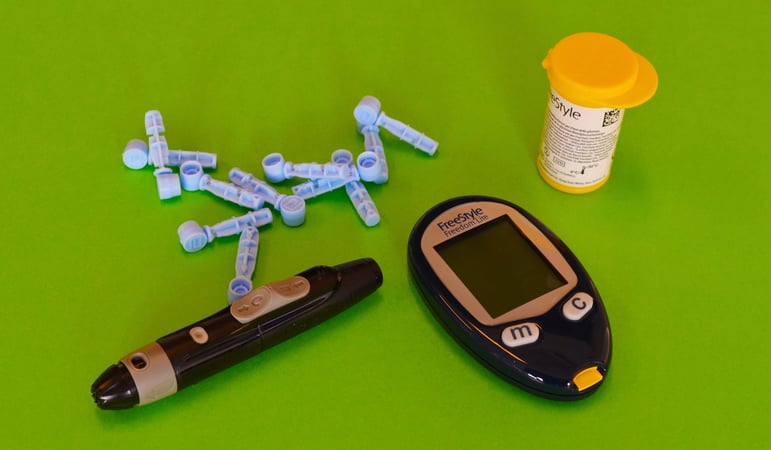EMC testing for wireless medical devices

Wireless technology has become a common feature of the medical device industry. From wearables to remote monitoring systems - small, portable devices are increasingly being used to provide more flexible care. For example, chronic conditions such as diabetes can now be monitored at home using a glucometer, while fall detection systems can be used to alert caregivers where assistance is needed. This not only improves the patient’s quality of life, but also cuts costs by freeing up hospital beds and healthcare professionals’ time.
However, this technology also gives rise to a new range of risks, particularly in relation to cybersecurity and data protection. As a result, manufacturers must now identify and implement systems to mitigate potential vulnerabilities arising from their wireless functionality. Another important area of risk that must be considered for wireless devices relates to electromagnetic compatibility (EMC). In this post, we discuss the importance of EMC considerations for manufacturers, as well as how to ensure a standard of compatibility that complies with the medical device regulations.
EMC considerations
EMC compliance for medical devices can be defined as ensuring that:
- Electromagnetic disturbances do not affect the essential performance and safety of medical devices, and
- Electromagnetic disturbances do not affect the functioning of other equipment.[1]
Consideration of EMC-related risks is a regulatory requirement in many jurisdictions. For example, in the EU, UK and Australia, it is explicitly addressed as part of the essential safety and performance requirements for medical devices.[2] EMC is also often regulated in its own right,[3] meaning that manufacturers of wireless medical devices may have to comply with multiple legislative frameworks in order to legally market their products.
Recent industry recalls highlight the importance of taking EMC requirements seriously. For example, back in October, the US Food and Drug Administration (FDA) announced the recall of Baxter Hillrom’s WatchCare Incontinence Management System. The recall was based on the finding that radiofrequency emissions from the system could interfere with other medical devices (including infusion pumps, foetal monitors and bladder scanners). Whilst no deaths or serious injuries have been linked to the WatchCare System, the interference could cause inaccurate readings or malfunctions, leading to inappropriate treatment.
Demonstrating compliance
The most common method for demonstrating EMC compliance for medical devices is through the implementation of standards. IEC 60601-1-2, in particular, sets out the requirements for electromagnetic compatibility and the tests that should be carried out to uphold this. The standard is divided into two parts - immunity and emissions. Under the first part, manufacturers must ensure that their devices do not fail or malfunction due to interference from other equipment. This is to be achieved through immunity testing, electrostatic discharge (ESD) testing, surge testing and magnetic field testing, for example. Under the second part of the standard, manufacturers must ensure that their devices do not negatively interfere with other equipment. The required tests here are radiated and conducted emissions tests, harmonics tests and flicker tests.
Based on the results of these tests, manufacturers should then consider what risk mitigation measures need to be put in place. This may involve certain warnings or markings being placed on the device and its packaging, as well as the instructions for use. In some cases, it may also be necessary to place limits on the use of the device, either in terms of the environments in which it is used (e.g. in a shielded location in a hospital setting only) or who it is used by (e.g. healthcare professionals only).
How we can help
Overall, EMC compliance is an incredibly important but sometimes overlooked aspect of the regulatory requirements for medical devices. Due to the portable, take-home nature of many wireless products it can sometimes be difficult to determine whether they qualify as medical devices (meaning they must comply with the specific medical device EMC requirements) or general health and wellbeing products. This is further complicated by the sheer volume of legal rules and supporting guidance that must be considered when determining if a product is a medical device.
Regtik, our healthcare regulatory explorer tool, can help you navigate this legal maze by walking your product through a series of simple questions designed to determine its qualification (and classification) status. If it is established that your product is a medical device, it will then provide you with a range of resources to support your regulatory compliance journey. This includes an essential requirements checklist, as well as information on which standards can be used to demonstrate compliance with each requirement.
If you are interested in learning more about Regtik or would like to request a demo, please contact any member of our team or register your interest below.
[1] TÜV Rheinland, EMC Compliance for Medical Devices
[2] For example, Annex I of the Medical Device Regulation in the EU, Annex I of the Medical Device Directive in Great Britain and Schedule I of the Therapeutic Goods (Medical Device) Regulations in Australia
[3] For example, the EMC Regulations in the UK and the EMC Directive in the EU




